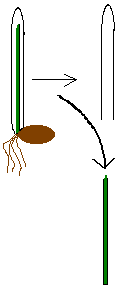
Coleoptile
Encyclopedia

Cotyledon
A cotyledon , is a significant part of the embryo within the seed of a plant. Upon germination, the cotyledon may become the embryonic first leaves of a seedling. The number of cotyledons present is one characteristic used by botanists to classify the flowering plants...
such as oats and grasses. Coleoptiles have two vascular bundles, one on either side. Unlike the flag leaves rolled up within, the pre-emergent coleoptile does not accumulate significant protochlorophyll or carotenoids, and so it is generally very pale. Some preemergent coleoptiles do, however, accumulate purple anthocyanin pigments.
Coleoptiles consist of very similar cells that are all specialised to fast stretch growth. They do not divide, but increase in size as they accumulate more water. Coleoptiles also have several (frequently two) water vessels along the axis to provide a water supply.
When a coleoptile reaches the surface, it stops growing and the flag leaves penetrate its top, continuing to grow along. The wheat coleoptile is most developed in the third day of the germination (if in the darkness).
Tropisms
Early experiments on phototropismPhototropism
Phototropism is directional growth in which the direction of growth is determined by the direction of the light source. In other words, it is the growth and response to a light stimulus. Phototropism is most often observed in plants, but can also occur in other organisms such as fungi...
using coleoptiles suggested that plants grow towards light because plant cell
Plant cell
Plant cells are eukaryotic cells that differ in several key respects from the cells of other eukaryotic organisms. Their distinctive features include:...
s on the darker side elongate more than those on the lighter side. In 1880 Charles Darwin
Charles Darwin
Charles Robert Darwin FRS was an English naturalist. He established that all species of life have descended over time from common ancestry, and proposed the scientific theory that this branching pattern of evolution resulted from a process that he called natural selection.He published his theory...
and his son, Francis
Francis Darwin
Sir Francis "Frank" Darwin, FRS , a son of the British naturalist and scientist Charles Darwin, followed his father into botany.-Biography:Francis Darwin was born in Down House, Downe, Kent in 1848...
found that coleoptiles only bend towards the light when their tips are exposed. Therefore the tips must contain the photoreceptor cells although the bending takes place lower down on the shoot. A chemical messenger or hormone
Hormone
A hormone is a chemical released by a cell or a gland in one part of the body that sends out messages that affect cells in other parts of the organism. Only a small amount of hormone is required to alter cell metabolism. In essence, it is a chemical messenger that transports a signal from one...
called auxin
Auxin
Auxins are a class of plant hormones with some morphogen-like characteristics. Auxins have a cardinal role in coordination of many growth and behavioral processes in the plant's life cycle and are essential for plant body development. Auxins and their role in plant growth were first described by...
moves down the dark side of the shoot and stimulates growth on that side. The natural plant hormone
Plant hormone
Plant hormones are chemicals that regulate plant growth, which, in the UK, are termed 'plant growth substances'. Plant hormones are signal molecules produced within the plant, and occur in extremely low concentrations. Hormones regulate cellular processes in targeted cells locally and, when moved...
responsible for phototropism is now known to be indoleacetic acid (IAA).
Coleoptiles also exhibit strong geotropic reaction, always growing upward and correcting direction after reorientation. Geotropic reaction is regulated by light (more exactly by phytochrome
Phytochrome
Phytochrome is a photoreceptor, a pigment that plants use to detect light. It is sensitive to light in the red and far-red region of the visible spectrum. Many flowering plants use it to regulate the time of flowering based on the length of day and night and to set circadian rhythms...
conversions). The direction of this regulation (stimulation or suppression) varies between species and even between varieties.

